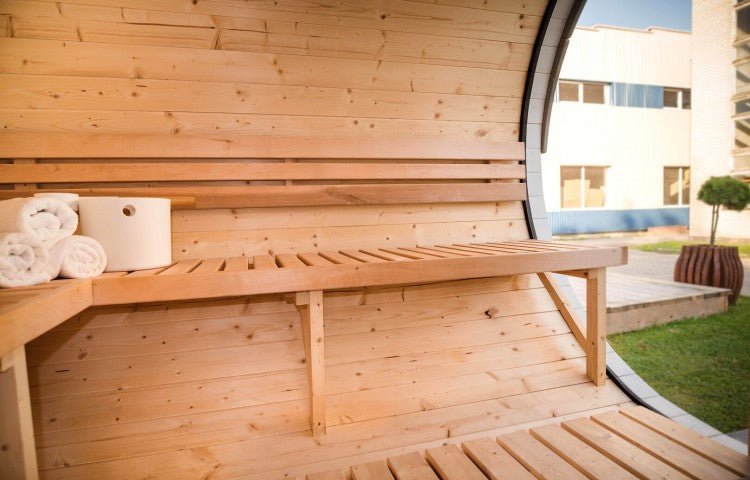Torn between a Sauna and an Infrared Sauna for your Home, Garden, or Outdoor setup? The short answer: both work—but in very different ways. Keep reading to see which one fits your health goals, lifestyle, and space.

Understanding the Core Differences: Infrared vs. Traditional Saunas
A traditional sauna heats the air around you, raising the ambient temperature to induce sweating. It’s the classic steamy room you picture at a spa.
An infrared sauna, however, uses radiant heat to warm your body directly. There’s no steam—just a gentle heat that penetrates deeper beneath the skin.
The core difference lies in how they heat you. One warms the space; the other targets you directly.
How They Heat You: Mechanism and Temperature

Traditional Saunas: Heating the Air
A traditional Finnish-style sauna heats the air using electric, gas, or wood-burning heaters. These heaters warm rocks that radiate heat throughout the room.
Adding water to the rocks creates steam, which raises humidity. Whether dry or wet, it’s about ambient heat. The air warms first, then your body follows.
Infrared Saunas: Direct Body Heating
Infrared saunas skip the air and heat you directly using far-infrared lamps or carbon panel heaters. These waves penetrate deep into your tissues.
The result? A sweat-inducing session at much lower temperatures, with no steam and a drier environment.
Temperature Ranges and Humidity Levels
Traditional saunas reach 80°C to 100°C with high humidity if steam is added. Infrared saunas sit comfortably between 45°C to 60°C, with low humidity.
If you dislike intense heat or struggle to breathe in steamy rooms, the lower temp of infrared may feel more pleasant.
Practical Considerations for Ownership and Use
Heat-Up Time
Infrared saunas heat up in under 10 minutes. Traditional ones? You’re often waiting 30–40 minutes for full warmth.
Running Costs and Energy Efficiency
Infrared saunas are typically more energy-efficient, using less power and running at lower temperatures. That means lower operational costs over time.
Installation, Space, and Portability
Infrared models often come in DIY kits, fit for indoor spaces, and don’t need special ventilation.
Traditional saunas might require professional installation, especially if you’re building an outdoor sauna with wood heaters or planning a garden sauna.
Maintenance Requirements
Infrared saunas have fewer parts and no steam, making them easier to clean. Traditional units need regular checks for mould, mildew, and heater residue.
Session Duration and Experience
You’ll spend 15–30 minutes in a traditional sauna, while 20–45 minutes is common for infrared.
Some prefer the intense steam of a traditional unit. Others enjoy the gentle dry heat of infrared sessions.
Health Benefits: A Deep Dive into Both Sauna Types
Shared Therapeutic Advantages
Detoxification and Sweating
Both saunas encourage deep sweating, aiding the removal of toxins, impurities, and heavy metals from your body.
Cardiovascular Health and Circulation
Raising your heart rate mimics light cardio. Blood vessels expand, blood pressure improves, and circulation increases.
Pain Relief and Muscle Recovery
Regular sauna use may ease sore muscles, reduce joint pain, and speed up post-exercise recovery.
Stress Reduction and Mental Well-being
Sauna sessions help lower cortisol, raise endorphins, and improve mood and sleep quality.
Skin Health
The heat opens pores, removes impurities, and enhances skin appearance over time.
Immune System Support
Increased circulation and heat exposure may help the body resist common colds and minor infections.
Unique Benefits and Research Insights
Traditional Sauna: Established Research and Heat Stress Benefits
Research links regular traditional sauna use to reduced risk of heart disease, dementia, and Alzheimer’s. It may also support longevity and lower hypertension.
Infrared Sauna: Deeper Penetration and Specific Conditions
Infrared therapy has shown benefits for fibromyalgia, chronic fatigue syndrome, and rheumatoid arthritis. Therapies like Waon therapy use far-infrared to ease chronic symptoms.
Considerations Regarding Research and EMF
While traditional sauna benefits are well-studied, research on infrared is still limited. Be cautious of marketing claims, and note the potential for electromagnetic field (EMF) exposure in poorly built infrared units.
Choosing Your Ideal Sauna: Which One is Right for You?

Factors to Consider Before Deciding
Personal Heat Tolerance and Comfort Preferences
If you dislike extreme heat, infrared’s gentle warmth might be better. Prefer steam and sweating buckets? Stick with traditional.
Specific Health Goals
For detox, pain management, or relaxation, both saunas help—but infrared may offer more targeted therapeutic benefits.
Budget and Investment
Infrared saunas usually have a lower purchase cost and cheaper long-term running costs. Traditional models, though, offer a classic spa-like experience.
Available Space and Installation Needs
Limited space? Choose an infrared home sauna. Building a garden sauna or outdoor sauna? A traditional setup might be more robust and authentic.
Safety Guidelines and Best Practices
Hydration and Session Limits
Always drink plenty of water before and after. Limit sessions to 30–45 minutes, and avoid overheating or dehydration.
Who Should Avoid Saunas
Those with heart issues, low blood pressure, or other medical conditions should consult a doctor before using either type. Saunas aren’t suitable for pregnant women or young children.
Combining Sauna Types for Enhanced Benefits
If you’re lucky enough to own both—or have access to a spa—combining traditional and infrared sessions could give you the best of both worlds. Alternate between them based on your mood, goal, or available time.
Takeaways
-
Traditional saunas offer steam, higher heat, and long-established health research.
-
Infrared saunas give you gentle warmth, deeper tissue penetration, and lower costs.
-
Consider your space, budget, health goals, and comfort preferences.
-
Always use saunas safely, stay hydrated, and listen to your body.






